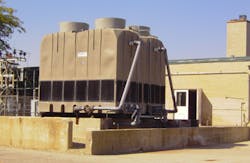There is a growing need for remediation and recycling of soil, sludge and other materials containing a wide range of organic contaminants such as found in oil sludge ponds, oilfield drill cuttings, tank bottoms dregs and soils contaminated with a host of other hydrocarbons.
Indirect thermal desorption is a remediation process that separates organic constituents from a waste stream. Useful materials, including hydrocarbons, are recovered in such a manner that they are preserved for collection and recycling.
"The concept is much different than the traditional approach — transporting waste material to a hazardous waste landfill or incineration facility where the valuable hydrocarbons are invariably burned and released to the atmosphere in the form of greenhouse gases," says Tony Dollins, a vice president with Richmond, Va.-based RLC Technologies.
"With our thermal desorption technology, materials can be treated on site. Treatment is accomplished through indirect heating of the feed material in an anaerobic — or oxygen-deficient — environment. The separation process not only allows the operator to recover the hydrocarbons in the waste, but also prevents the formation of dioxins, furans or other toxic gases that would otherwise escape to the atmosphere. The remaining solid fraction, or soil, is rendered non-hazardous and may be de-listed, allowing for disposal in a non-hazardous landfill. This avoids costly hazardous waste disposal fees."
RLC Technologies was one of the original pioneers of these systems, manufacturing its first anaerobic thermal desorption unit (ATDU) in 1997 when the company was founded by Dr. Robert L. Carroll, who currently serves as president and CEO.
Today, more than 30 such ATDU systems are installed in refineries, oilfields and waste processing facilities around the world, owned and operated by environmental and remediation services companies. The system’s effective hydrocarbon removal and recycling capabilities, ease of regulatory emission permitting, and acceptance by the general public are key factors in its popularity among the refineries and the cleanup contractors throughout the world, RLC Technologies says.
Handling the heat
Heat is an essential ingredient in the ATDU’s process. Rather than burn the contaminated materials being treated, they are placed inside a drum and heated from the outside.
"Our system elevates the temperature of the waste stream beyond the boiling point of the contaminants," Dollins explains. "The oxygen deficiency prevents the hydrocarbons from burning. Instead of combusting, they phase-change into a gas and are extracted via vacuum from the rotary chamber. Vaporized hydrocarbons are delivered to the vapor recovery unit where they are cooled and condensed back into liquid form. In this process, the hydrocarbons are simply separated from the waste material, not oxidized or otherwise destroyed."
A water-cooled heat exchanger draws off the heat from the process driving the hydrocarbon gas condenser unit, facilitating recovery so that hydrocarbons can be "bottled" for future use. As a continuous system, the water must be reduced in temperature before it loops back through the system. A desorption unit generates a vapor stream of typically 4,000-5,000 CFM, Dollins explains. "By the time they come through our condensation system, the vapors are down to 200-400 CFM and temperature level drops from about 1,000 F down to approximately 55 F."
Ultimately, all of that heat has to be removed by the cooling towers. "This makes the cooling towers an essential component of the ATDU plant," Dollins says. "Because our systems are designed to operate 24/7 for 15-20 years, our systems must include cooling towers that are reliable and have a long service life."
For those reasons, companies that operate cooling systems in harsh environments often include HDPE (high-density polyethylene) plastic cooling towers, such as those manufactured by Rockaway, N.J.-based Delta Cooling Towers, which have a seamless shell impervious to water treatment chemicals and the harsh environments, either natural or industrial.
Uptime critical
"This is especially important for systems located in hot, humid environments or areas in close proximity to salt water which can be very damaging to typical metal cooling towers," Dollins says. "With the loss of production dollars that any service or replacement downtime represents, we need the most reliable cooling towers available."
Cooling efficiency is also important to the volume of hydrocarbon recovery processing, and the HDPE cooling tower designs maintain that efficiency. The cooler the water, the more efficient the condensation process, and the more hydrocarbons will be condensed and preserved for recycling.
In the past, plastic cooling towers were too small for many industrial and commercial facilities or required extensive field assembly. However, today, Delta, for example, has introduced a series of U.S. made factory-assembled plastic towers to suit almost any size requirements up to 2,000 cooling tons in a single, modularized unit.
System modularity also makes the cooling tower scalable, a highly desirable feature for those who have smaller or intermediate cooling requirements today, but may want to expand cooling capacity as the business grows.
For more information, contact Delta Cooling Towers, Inc., 41 Pine Street, Rockaway, NJ 07866; Phone: 800.289.3358; Fax: 973.586.2243; Email: [email protected]; or visit the website: www.deltacooling.com.



